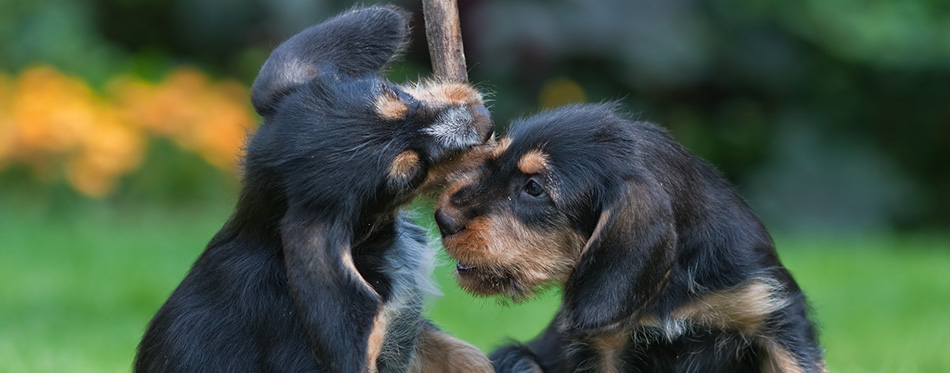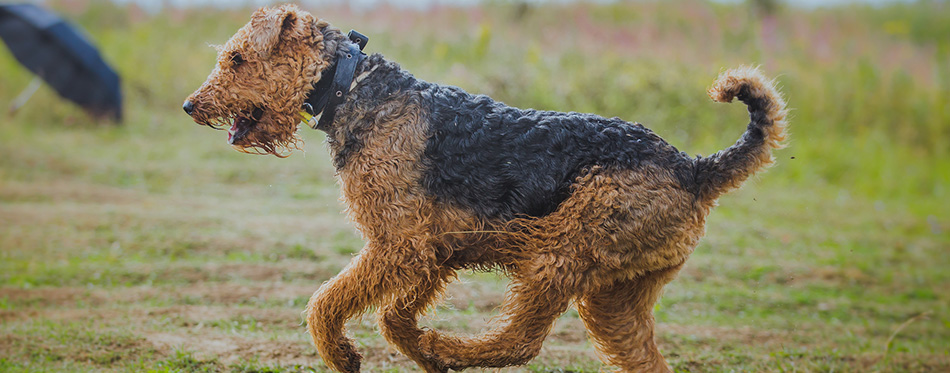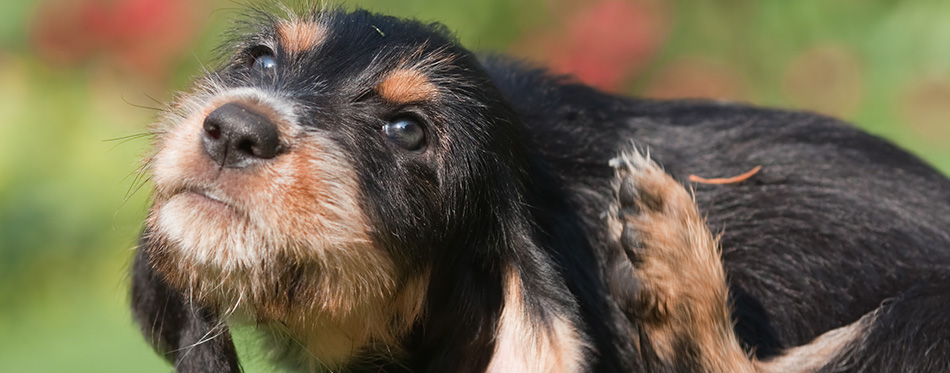Otterhounds are a large dog breed that have a very amiable nature. It is also even-tempered and can display boisterous behavior at times. It is an excellent hunter known for its remarkable scenting abilities. Unfortunately, there is not many of them left in the world. Learn more about these adorable dogs before they fade.

History of the Otterhound
It is quite difficult to ascertain the exact origin of the Otterhound that we know today. What we know is that there are many dogs that people used in hunting otters since the ancient times.
The earliest records of these otter-hunting hounds were those in 1200 AD. King John had several packs of dogs that hunted otters. However, historians pointed out that King John’s father, King Henry II, also enjoyed otter hunting. As such, it is possible that King Henry II also employed these otter-hunting hounds.
There are records that show the Otterhound is the direct descendant of either the Talbot or the St. Hubert hound. These are hounds that the Normans brought with them when they invaded England in 1066. Locals used these dogs in getting rid of otters that feed on fish.
Another ancestor of the modern-day Otterhound is the Chien Gris de St. Louis. This is a dog that the French used in hunting otters between 1250 and 1470. It is possible that some of these dogs crossed the English Channel with their masters. These dogs were then mated with either the St. Hubert or other otter-hunting dogs.
From the 13th century to the 19th century, many British monarchs kept hunting packs of otter hounds. There were also other people who began breeding the dog for its hunting abilities. Squire James Lomax of Lancashire is the most influential of the early otter hound packs. They had a rough coat which is characteristic of the modern-day Otterhound.
By the middle of the 19th century, French dog breeds were introduced to strengthen the hunting capabilities of the native otter hound packs of England. These included the Chien fauvre de Bretagne, the Griffon Nivernais, and the Griffon Vendeen. The Griffon Nivernais is the result of crossbreeding a Griffon de Bresse with a wild wolf. The aggressive nature of the wild wolf can help explain some of the aggressive tendencies of modern Otterhounds.
Otterhounds reached the United States in 1903. They participated in their first dog show in 1907 in Claremont, New Hampshire. Two years later, the AKC gave the Otterhound full recognition as a dog breed.
Quick Facts About the Otterhound
Here are a few other facts that we know about Otterhounds.
- It is a Large Dog
The Otterhound is a large canine breed that can weigh an average of 90.5 pounds. However, it is not unusual for males to reach up to 115 pounds, while females can weigh a maximum of 80 pounds. Male Otterhounds can also stand up to 27 inches tall. Female Otterhounds are often shorter by 3 inches.
This dog breed has a strong body that allows it to perform its fundamental duty of hunting otters. It is also strong and can have the energy of a Border Collie. It has long striding steps that allow it to cover more ground in less time.
- It is a Rare Breed
The Kennel Club of the UK says that there are only about 600 Otterhounds left in the whole world. There are 350 of these dogs in the US and Canada. There are other reports that say only 43 pairs of dogs remain that can continue the bloodline of the Otterhound. While this news can be heartbreaking, one should see it as a golden opportunity to help save the breed.
One of the reasons why there aren’t that many Otterhounds left is people’s indifference. These are large dogs that have high energy levels. Many potential dog owners do not have the active lifestyle that this canine breed is well suited for. Also, the Otterhound does not have any striking physical characteristics that can make people fall in love with it. There are now designer dogs and other canine purebreds that potential dog owners can choose.
- It Can Outclass the Bloodhound
We always knew that no other breed can match the Bloodhound’s tenacity in tracking. As it turns out, the Otterhound is more tenacious and more inquisitive than its droopy-eared cousin. Otterhounds are very efficient trackers. It is a scenthound that uses its remarkable sense of smell to track otters and other creatures. It can track scent both in the water and in mud for up to 72 hours. They also have a very inquisitive nature. This is another reason why some people may not like the Otterhound. It is a dog that will never stop being so nosy.
- It is an Excellent Swimmer
There are many dog breeds that are excellent swimmers; the Otterhound is one of them. This dog has the same webbed feet like the Poodle and other water-loving breeds. It also has a rough and oily double coat. No water is ever too cold for a dedicated Otterhound. Mother Nature gave the dog such anatomical features to help it hunt otters in the water.
- It has a Strong Impulse to Roam or Wander
Another reason why many people do not like the Otterhound is its high wanderlust tendency. This is not at all surprising, given the inquisitive nature and remarkable scenting abilities of the breed. It loves to explore the world beyond the borders of its house. A faint scent that it can pick up in the air is enough to trigger the dog to roam. It is not uncommon to find damaged fences because of the intense desire of the Otterhound to wander.
- It has a Strong Prey Drive
The otter-hunting instincts of the Otterhound remain strong in the breed. This is despite the fact that the breed has already outlived its original purpose. Families with other pets should think twice before getting an Otterhound. Small pets like cats and hamsters will never be safe in the company of an Otterhound.

Things You Should Know
Otterhounds can make adorable and excellent family companions if you know how to take care of it. The following things should give you an idea of the kind of care that an Otterhound requires.
Health
About a quarter of all Otterhounds can live up to 15 years. On average, however, they will only last up to 11 to 12 years. This is quite remarkable since most large dog breeds have an average lifespan of only 10 to 11 years.
This does not exempt the breed from the health conditions that are common among breeds of this size. For example, Otterhounds are susceptible to hip dysplasia that can have a significant effect on their mobility. They may experience pain and swelling of the hip joints. This can limit their movement. Since Otterhounds are rambunctious hounds, limiting their movements can have an effect on their mental health.
These dogs are also prone to gastric dilatation volvulus. Most of us know this as bloat. It has a deep chest that can promote the distention of the stomach when it gulps more air than is necessary. The distention of the stomach can lead to the twisting of the organ into itself. It can cut off vital blood to the adjacent organs.
Other health conditions that an Otterhound can have include seizures and epilepsy. What is surprising is that American Otterhounds do not display a fatal type of epilepsy. Their British counterparts, on the other hand, can suffer from a fatal form of epilepsy. This suggests a hereditary nature of the disease.
Training
Otterhounds are very easy to train if you have the skill and patience for it. This breed is very independent. It is important for its owner to convince the dog that it wants to perform the things that its owner is asking it to do. You will have to exercise a great deal of patience to get the Otterhound to do the thing that you want.
Skipping training altogether is out of the question. This is a dog that has a very strong desire to wander. Leash training is important. So is the art of recall. This will help you manage the tendency of the Otterhound to wander. Teaching it the “leave it” command can also help as the inquisitive behavior of this dog can lead it to more trouble than you can handle.
Exercise
This breed is a very proficient otter hunter. It is very persistent and dedicated to its work. It will never stop until it has the quarry in its mouth. It has strong and powerful leg muscles that can help it to walk, run, and swim over tens of miles at a time. That is why one of the fundamental requirements of owning an Otterhound is that its owner should have an active lifestyle.
Walking and running remain two of the favorite exercises of the breed. If you happen to live near a body of water, then this dog will be a lot happier. It loves to swim and romp in the dog park. Its playful nature and amiable temperament make it a good friend to other dogs. However, the same cannot be said of smaller pets. This breed has a high prey drive. It will attack smaller animals as if they are otters.
It is for this reason that one should always put the Otterhound on a leash whenever you take it out for a walk. You will never know if there are small pets in the area.
Nutrition
Otterhounds are prone to gastric dilatation volvulus. One of the ways you can lower the risk is by feeding the dog at least twice a day. This will help reduce the amount of food that it will consume with each feeding. An alternative will be to give it a calorie-dense diet. It needs energy for its many activities. This can also help reduce the amount of dog food per meal.
In general, a 100-lb Otterhound with normal activities should receive about 1,950 to 2,000 calories per day. You can give about 1,000 calories two times a day or about 667 calories three times a day.
Also crucial are nutrients that can help reduce the risk of hip dysplasia. You can give the Otterhound dog food that contains chondroitin and glucosamine.
Related Post: Automatic Dog Feeders
Grooming
The Otterhound has a shaggy coat that can shed almost all year round. It requires frequent brushing as the coat tends to form tangles and mats. Brushing its coat at least two times a week should help keep it healthy and shiny. One has to wash the dog’s beard every day. It can get dirty and soiled every time it eats or the dog lies down on the floor. If you do not wash it, the dog’s beard can develop a stinky smell.
Dental hygiene is also important for the Otterhound. Daily brushing is ideal. If this is not possible, then one should try to brush the dog’s teeth at least once every 3 days. This will prevent the development of gum disease.
Clip the Otterhound’s nails every month. Check its droopy ears every week as dirt can accumulate inside. You need to clean it and check for signs of inflammation.
You may find helpful some of our dog grooming guides, such as dog toothbrush, dog toothpaste, dog ear cleaners, dog wipes and dog shampoo.

Temperament
The head of the Otterhound gives the dog a dignified impression. Underneath this noble look is the childlike, playful, and joyful heart. This dog has a very wonderful personality that can make it a great companion for many families. It will greet you when you come home. However, it also has a strong sense of independence that it will never shadow you around the house. It is an affectionate breed that can enjoy outdoor activities as much as it loves staying on the couch all day.
Otterhounds are excellent with older kids. We have to emphasize “older” here because of the size of the dog. They can still play with smaller and younger children, provided you exercise close supervision. These dogs have high energy that they can use to play with older children.
It is sad to learn that there aren’t many Otterhounds left in the world. Given the proper care and attention, these dogs can make excellent companions for the modern family.
Sources:
- Meet the Breed – The Otterhound Club of America
- Otterhound – AKC

